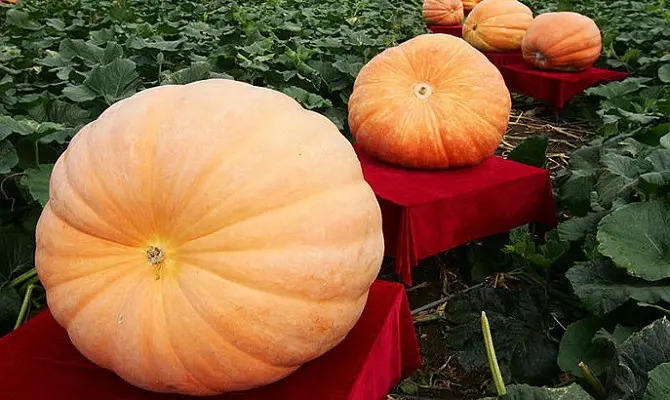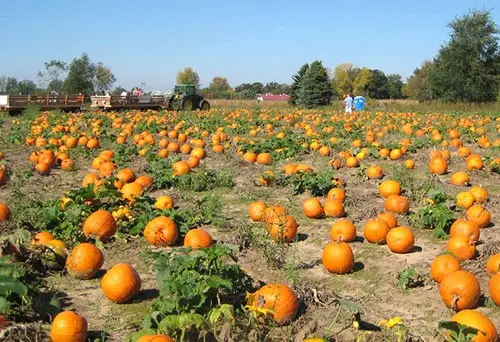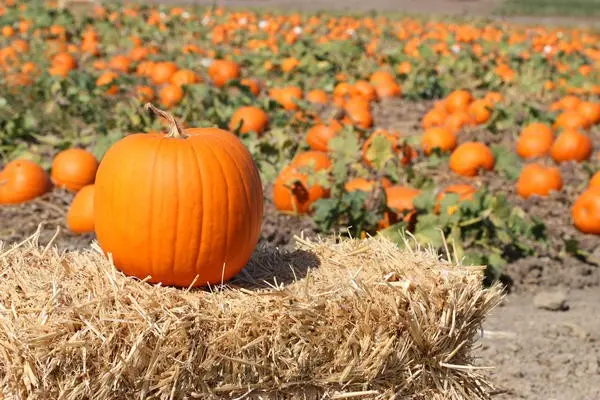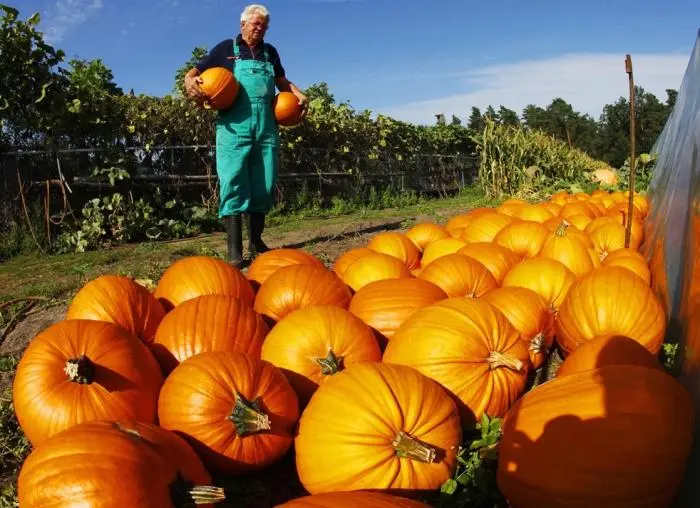Contents


Harvesting in the garden in the fall is the result of all previous work. One of the last pumpkins is removed from the land, as this culture is quite unpretentious in care and cold-resistant. But not every gardener knows when to harvest a pumpkin. This article will be devoted to this issue.
Terms of maturation
The timing of pumpkin ripening depends on its variety. Today, on the territory of our country (Moscow region, Siberia, the Urals and other regions), the following varieties of this crop are grown:

- early. The most popular of them are Mozoleevskaya 49, Golosemyannaya, Almond 35, Biryuchekutskaya 27, Freckles, etc. For them, the ripening period is approximately 3,5 months (92-104 days). Harvesting of these varieties begins in mid-late August. This is due to the fact that the fruits have a thin shell and are quite tender. Therefore, they can be stored for no longer than a month;
- mid-season. This group includes varieties Smile, Winter Sweet, Kroshka, Volga Gray, One Hundred Pound, Medical, Rossiyanka, etc. The maturation period in this case is 4 months (110-120 days). Pumpkins of these varieties need to be harvested in mid-September, but you need to have time before the onset of the first frost. In the Moscow region, such varieties begin to be harvested from mid-September. If the pumpkin is frozen, then it will not be possible to store it for a long time.
- late-ripening (hard-barked). Of these, the most popular varieties are Muscat, Zhemchuzhina, Vita, Testi Delife, Interception, Vitamin and Baternat Ponca. With a thick shell, such pumpkins can be stored for up to six months. Harvesting of these varieties usually begins in mid – late September. At the same time, the ripening period here is approximately 200 days. Therefore, still ripened fruits are being harvested, which ripen during the storage period.
In addition, the climatic conditions of the place of growth can also affect the time of ripening and harvesting of pumpkins. In the south of the country, fruits can be in the garden for a long time. This is due to late frosts. At the same time, in the Moscow region, Siberia and the Urals, it is imperative to have time to remove the fruits from the garden before the arrival of frost.
How to determine the ripeness of a vegetable

By the time of harvesting from the garden, the pumpkin should be ripe (with the exception of late-ripening varieties). To determine whether a vegetable is ripe, it is necessary to be guided by external signs of maturity. Knowing these signs will allow you to accurately determine whether the pumpkin is ready for harvesting from the garden. This is especially important for beginner gardeners.
Fruits that are ripe have the following external signs:
- woody stem. This means that it should look hard and dry, not green and juicy;
- the plant should have yellowed or faded leaves. In this case, at least part of the sheet plate must be dried. The same signs are preserved not only for the leaves, but also for the wattle itself;
- pumpkin is bright and rich in color. At the same time, depending on the variety, its color can be from yellow and gray-green to saturated or dark orange. It should be noted that not all varieties change the color of the fruit. This is for the wax gourd. There are plants whose fruits keep the bark white or gray even when fully ripe;
- the shell of the fetus has acquired density and become more rigid.
Knowing the above signs of vegetable ripeness, as well as focusing on the ripening time, you can easily determine that the pumpkin is ready for harvest, wherever your site is located (in the Moscow region, Siberia, the Urals or other regions). As a rule, the terms are written on the back of the seed packets, which is very convenient to remember.
Please note that only ripe varieties need to be stored (with the exception of late ripening ones). For not quite ripe vegetables, a ripening procedure should be carried out in order to fully protect it from the effects of the external environment. Such fruits will be stored for a long time, preserving the pleasant taste of the pulp.
Video “Pumpkin and everything about it”
When and how to remove from the garden

In order to correctly determine the time for harvesting pumpkins from the beds, one should be guided by the ripening time and the appearance of the fruits and plants. At the same time, in such regions as the Urals and the Moscow region, climatic factors – frosts – are a very important point. In case of overexposure of pumpkins in the garden (if they are frozen), then they cannot be stored. Such vegetables should be put into the preparation of home canned food and juices.
To minimize the risk of freezing, the fruits must be cut in early September (slightly earlier than the established ripening period) and allowed to ripen at home. At the same time, in the daytime (especially on sunny days), pumpkins should be taken out into the street.
For Siberia, a fairly large region of our country, the timing of harvesting from the garden may differ in different areas. Here, gardeners prefer early-ripening varieties that ripen in about 100 days. At the same time, it is possible to start harvesting such varieties starting from the 75th day from the moment the seeds are planted in the ground. To store such fruits, they practice their ripening at home for 2-3 weeks. Fruits should be this period at room temperature.

Also, for the assembly of pumpkins in all regions of the country, there are certain recommendations that are common to all varieties. This includes the following set of rules:
- the weather must be dry;
- frosts are absent;
- in rainy weather, the harvested vegetables must be dried well;
- when cutting the fruit, a stalk about 3-4 cm long should be left. You need to cut it with a sharp knife, and not tear it off the wattle with your hands. Vegetables without a “tail” lose their natural defenses. Through the plucked “tail”, fungi and pathogenic bacteria can penetrate into the fruits;
- avoid damage to vegetables, as this leads to poor keeping quality;
- large fruits must be collected separately. At the same time, they should be sent for processing 1-1,5 months after harvesting.
Harvesting must be carried out very carefully, carefully treating each individual pumpkin. In addition to mechanical damage to pumpkins, they should not fall on the ground. This can lead to the onset of decay processes from the inside. In such a situation, one bad vegetable can spoil all the others. After assembly, vegetables should be stored in well-dried rooms, avoiding the appearance of moisture in them. Otherwise, it will lead to their decay.

Separately, it is worth noting that in the northern regions of the country, where for the most part early-ripening varieties are grown, gardeners, when harvesting, are guided not only by the appearance of the fruit, but also by meteorological indications. This is due to the fact that the climatic conditions here are unstable and it is better to harvest in advance, because the fruits can always ripen at home. Otherwise, there is a risk that vegetables may suffer from the first frost, and this will negatively affect their shelf life.
As you can see, despite its unpretentiousness in care, the pumpkin has certain requirements for its cleaning. Following all the recommendations will allow you to get a quality crop and store it properly.
Video “How to grow and harvest a pumpkin”
In this video, you will learn what and how to do in order to harvest the largest possible harvest of ripe pumpkin.
Author: Svetlana Galitsina
Loading…










